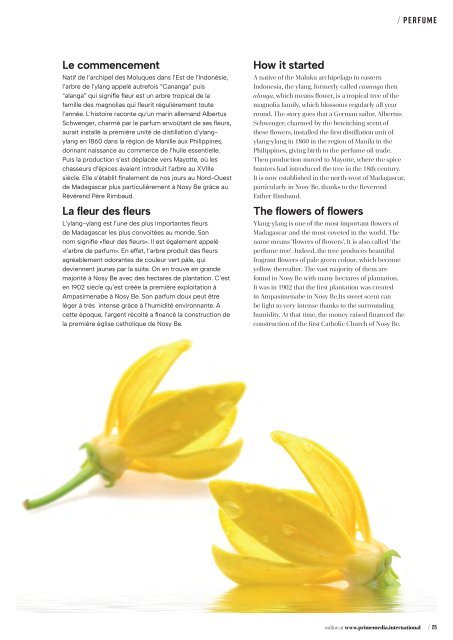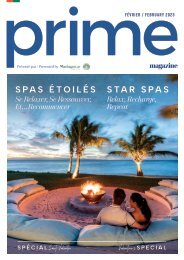Prime Magazine Mars / March 2023
Create successful ePaper yourself
Turn your PDF publications into a flip-book with our unique Google optimized e-Paper software.
PERFUME<br />
Le commencement<br />
Natif de l’archipel des Moluques dans l’Est de l’Indonésie,<br />
l’arbre de l’ylang appelé autrefois “Cananga” puis<br />
“alanga” qui signifie fleur est un arbre tropical de la<br />
famille des magnolias qui fleurit régulièrement toute<br />
l’année. L’histoire raconte qu’un marin allemand Albertus<br />
Schwenger, charmé par le parfum envoûtant de ses fleurs,<br />
aurait installé la première unité de distillation d’ylangylang<br />
en 1860 dans la région de Manille aux Philippines,<br />
donnant naissance au commerce de l’huile essentielle.<br />
Puis la production s’est déplacée vers Mayotte, où les<br />
chasseurs d’épices avaient introduit l’arbre au XVIIIe<br />
siècle. Elle s’établit finalement de nos jours au Nord-Ouest<br />
de Madagascar plus particulièrement à Nosy Be grâce au<br />
Révérend Père Rimbaud.<br />
La fleur des fleurs<br />
L’ylang-ylang est l’une des plus importantes fleurs<br />
de Madagascar les plus convoitées au monde. Son<br />
nom signifie «fleur des fleurs». Il est également appelé<br />
«l’arbre de parfum». En effet, l’arbre produit des fleurs<br />
agréablement odorantes de couleur vert pâle, qui<br />
deviennent jaunes par la suite. On en trouve en grande<br />
majorité à Nosy Be avec des hectares de plantation. C’est<br />
en 1902 siècle qu’est créée la première exploitation à<br />
Ampasimenabe à Nosy Be. Son parfum doux peut être<br />
léger à très intense grâce à l’humidité environnante. A<br />
cette époque, l’argent récolté a financé la construction de<br />
la première église catholique de Nosy Be.<br />
How it started<br />
A native of the Maluku archipelago in eastern<br />
Indonesia, the ylang, formerly called cananga then<br />
alanga, which means flower, is a tropical tree of the<br />
magnolia family, which blossoms regularly all year<br />
round. The story goes that a German sailor, Albertus<br />
Schwenger, charmed by the bewitching scent of<br />
these flowers, installed the first distillation unit of<br />
ylang-ylang in 1860 in the region of Manila in the<br />
Philippines, giving birth to the perfume oil trade.<br />
Then production moved to Mayotte, where the spice<br />
hunters had introduced the tree in the 18th century.<br />
It is now established in the north-west of Madagascar,<br />
particularly in Nosy Be, thanks to the Reverend<br />
Father Rimbaud.<br />
The flowers of flowers<br />
Ylang-ylang is one of the most important flowers of<br />
Madagascar and the most coveted in the world. The<br />
name means 'flowers of flowers'. It is also called 'the<br />
perfume tree'. Indeed, the tree produces beautiful<br />
fragrant flowers of pale green colour, which become<br />
yellow thereafter. The vast majority of them are<br />
found in Nosy Be with many hectares of plantation.<br />
It was in 1902 that the first plantation was created<br />
in Ampasimenabe in Nosy Be.Its sweet scent can<br />
be light to very intense thanks to the surrounding<br />
humidity. At that time, the money raised financed the<br />
construction of the first Catholic Church of Nosy Be.<br />
online at www.primemedia.international / 25
















